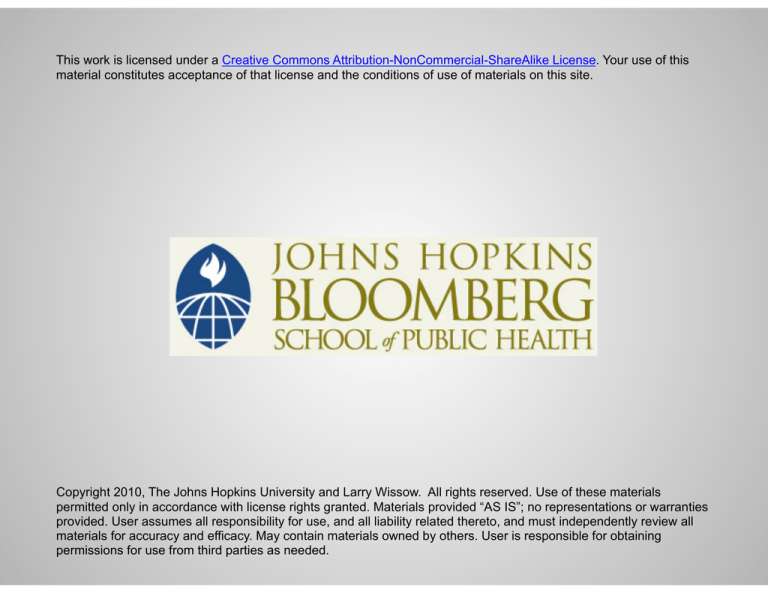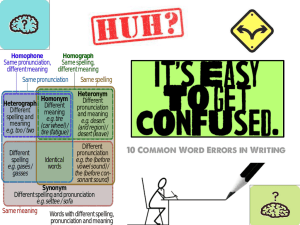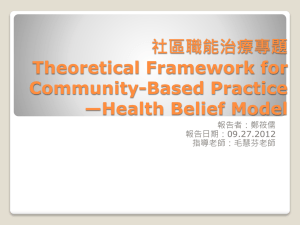
This work is licensed under a Creative Commons Attribution-NonCommercial-ShareAlike License. Your use of this
material constitutes acceptance of that license and the conditions of use of materials on this site.
Copyright 2010, The Johns Hopkins University and Larry Wissow. All rights reserved. Use of these materials
permitted only in accordance with license rights granted. Materials provided “AS IS”; no representations or warranties
provided. User assumes all responsibility for use, and all liability related thereto, and must independently review all
materials for accuracy and efficacy. May contain materials owned by others. User is responsible for obtaining
permissions for use from third parties as needed.
Intra-­‐Psychic Influences on Health Related Behavior Larry Wissow ISBT II Outline
“Truths” about behavior change
It’s all a reflex
It’s a socially-modified reflex
It’s mostly rational
It’s bounded rationality (and how brain is wired)
It’s emotions (somatic marker hypothesis)
Some work-arounds
Truths about behavior change
Canadian Institutes of Health Research, IHDCYH
“Truths” about behavior change
Change is difficult -­‐
Our brains are wired to preserve behaviors that have been learned (though maybe reversible more than we thought) Family members and others in the social environment are powerful forces Many structural features of the environment promote behaviors that we wish to iniKate or stop Example of food
CondiKoned responses related to eaKng very hard to exKnguish EaKng is a social acKvity that usually takes place in the company of others The environment has a huge influence on what we eat Lunch Line Redesign
Put nutritious food at beginning rather than middle of line
Give healthy foods appealing descriptive names, ie, “creamy”
Choice of healthy foods rather than only one offered
Keep sweet treats in opaque-covered container
Decrease bowl size for cereal
Use trays to encourage non-compact food
Put salad right before register rather than off to side
Ask, “do you want salad?”
Cash-only cookies
Speedy checkout if no cookies
For New York Times infographic
http://www.nytimes.com/interactive2010/10/21/opinion/20101021_Oplunch.html
Wansink, Just, McKendry, NYT 10/22/10; See also Wansink B, Physiology & Behavior, 2010;100:454:
1. It’s all reflexive
Classical condiKoning
“Pavlov’s dog” -­‐
Food is the uncondiKoned sKmulus (US) (also called “sKmulus control”) -­‐
Bell was neutral but now is the condiKoned sKmulus (CS) -­‐
SalivaKon was UR then becomes the condiKoned response (CR) Common examples? MarKn and Dubbert? Operant condiKoning
Behaviors (“operants”) posiKvely or negaKvely re-­‐
enforced by reward or punishment -­‐
Re-­‐enforcers consistent and immediate -­‐
Contracts can make them explicit -­‐
Can include seSng one’s own goals and anKcipaKng set-­‐
backs “Shaping” – start desired change at level where likely to succeed, provide lots of posiKve re-­‐
enforcement Operant condiKoning
GeneralizaKon training -­‐
Moving the behavior to mulKple seSngs Fading external re-­‐enforcement to self-­‐monitoring (or a combinaKon) Relapse prevenKon -­‐
AnKcipaKng environmental changes that will remove cues or change re-­‐enforcers -­‐
AnKcipaKng barriers -­‐
Development of coping mechanisms for setbacks SKmulus control
Want to develop new response to old sKmulus that is resulKng in an unwanted behavior -­‐
Use reward to favor the new sKmulus -­‐
Fade the reward Example: eat when faKgued and nervous -­‐
AlternaKve: take a brisk walk -­‐
Reward: put money in “piggy bank” at end of walk -­‐
Fade reward as able to eat less ExKncKon
Is the condiKoned behavior ever gone? -­‐
No longer happens spontaneously or with sKmulus DesensiKzaKon -­‐
Present sKmulus -­‐
Reward delay or non-­‐response -­‐
Punish response But o[en returns in new seSng Using behavioral intervenKons
Overt, easily measurable behaviors
OpportuniKes for learning
Clear understanding of re-­‐enforcers 2. Socially-modified reflexes
Society cogniKve theory
Albert Bandura 1960’s
Advances: -­‐
Re-­‐enforcement could be and was o[en vicarious -­‐
Learning can take place by watching others -­‐
Humans not just reacKve to the environment
Have their own potenKally unique goals
Able to act on the environment
Use cogniKon to construct their reality Social cogniKve theory Source: Pajares (2002). Overview of social cogniKve theory and of self-­‐efficacy. 12-­‐8-­‐04. From hfp://www.emory.edu/
EDUCATION/mfp/eff.html. Social cognitive theory
US DHHS/NIH/NCI “Theory at a glance”
3. It’s mostly rational
Health Belief Model
Based on “value expectancy theory”
CombinaKon of behaviorism and cogniKon
Developed in 1950’s to understand response to TB screening Hochbaum 1958 data on TB screening 1. Perceived suscepKbility -­‐
could you have TB even if you felt well? 2. Perceived benefits of screening -­‐
-­‐
would an X-­‐ray be able to find the TB? would early detecKon and treatment make a difference? % obtaining X-­‐ray: -­‐
if “yes” to (1) and (2) 82% -­‐
if “no” to (1) and (2) 21% Main components of the HBM
Perceived suscepKbility
your chances of geSng the condiKon/problem
try to personalize as much as possible
work on accurate percepKon Perceived severity
how serious will the consequences be?
try to make as specific and individualized as possible Main components of the HBM
Perceived benefits
Perceived barriers
what would be the outcome of acKng? with regard to the specific acKon that is proposed can be psychological or material Self-­‐efficacy (added later)
confidence in ability to take acKon may vary greatly with specific behaviors Health Belief Model perceived suscepKbility perceived benefits perceived barriers perceived severity behavior change self-­‐efficacy 4. Just how rational? “Bounded
rationality”
a. CogniKve limits on data manipulaKon •
–
ObservaKon: persuasive messages that target complicated acKons less likely to succeed –
ComplicaKons can be social or pracKcal – common issue is need for mulKple steps, integraKng large amounts of data, varying opinions, mulKple probabiliKes –
Too many choices lead people to choose poorly or not choose at all Are there really just 7 chunks? Limits on data processing
Experiment with beSng on horses -­‐
10 more parameters versus 5
-­‐
Increased confidence No increase in accuracy Decreased reliability AddiKonal informaKon not used Availability bias -­‐
Focus on most recently or frequently encountered relevant issue EducaKon and “pre-­‐processing” as alternaKves
FDA labelling -­‐
StandardizaKon of report “Consumer Reports” grids -­‐
Data simplificaKon -­‐
Expert opinion -­‐
Graphical presentaKon b. Problems with “framing” Tversky and Kahneman: decisional frame is "decision-­‐maker's concepKon of the acts, outcomes, and conKngencies associated with a parKcular choice" Any given decision problem can be framed in more than one way. They compare it to a visual image: for example, height of two mountains -­‐-­‐ relaKve height varies with the direcKon you look from, but we know that the mountains aren't changing despite the illusion Gain versus loss
Imagine that you just found $50. You have to
pick one of the following options (A or B)
Gambit A (sure outcome)
-
Keep $20
-
Lose $30
Gambit B (gamble)
-
Gamble that has 40% chance of keeping all $50
and 60% chance of losing all $50
“Framing” A as “keep” increases likelihood of
going for the sure option
Gain versus loss
One way frames may work is through an initial
“emotional” evaluation of the choice
Takes action of a different brain area to override that initial emotional choice
Activity in yet a third area relates to the general
tendency a person has to be able over-ride the
initial emotional evaluation
Kahneman and Frederick, Trends in Cognitive Sciences 2006
Gain versus loss
Positive and negative “utilities” get different
weights
-­‐
Losses weighted relaKvely more strongly than gains, and so they are avoided -­‐
Displeasure of losing 100 > pleasure of geSng 100 Re-­‐interpretaKon of probabiliKes -­‐
Low probabiliKes associated with bad outcomes are over-­‐ weighted relaKve to high probability needs -­‐
Chose health plan with great catastrophic coverage but high co-­‐pay for prevenKve care
c. Other violaKons of uKlity model a. Values o[en formed in discussion Co-­‐constructed in discussion with/reacKon to others b. RelaKve versus absolute differences: 10-­‐20 bigger than 100-­‐120 (frequent issue with large purchases) c. Difficulty anKcipaKng future needs or how values may change Perceived vulnerability
Key factor in nearly all health behavior theories Seem to be good examples of applicaKons to behavior change campaigns Smoke detectors (at least buying it) -­‐ Cancer screening -­‐
Variable VMPC sensiKvity to cogniKve input
Brain structure (old:new/posterior:anterior) relates to sensiKvity to informaKon – speed and saliency of response Time: present/frequent versus distant/
infrequent
Specificity: concrete versus abstract
Probability: greater versus lesser VMPC-isms
Losing $1000 tomorrow is harder to
contemplate than losing $2000 next year
Credit is more abstract than real money
(charging $20 seems less of a loss than
handing over a $20 note)
5. Somatic marker hypothesis
May relate to emotional valences associated
with frames
What/why emoKons •
Part of homeostaKc, regulatory mechanisms –
•
•
Linked to neural and hormonal responses Reflect the state of the body as it is or as it might be in the future Linked to/trigger complicated “reflexes” that include physiologic and behavioral changes What/why emoKons
Primary: fear, anger disgust, surprise, sadness, happiness Social emoKons: sympathy, embarrassment, shame, guilt, pride, jealousy, envy, graKtude, admiraKon, indignaKon, contempt “Gut” feelings are the basis of human “logic” -
Create the link between what we “know” and what we “do” by giving that knowledge emoKonal value EmoKons and learning
Brain highly adapted to rapidly and unconsciously assigning emoKonal value to situaKons, things, people EmoKonal learning is very hard to erase Behavioral triggers based on emoKons compete with informaKon coming from memories and “facts” Behavioral pathways Memory SKmulus Pre-­‐frontal cortex Brain emoKon center Fast Slower Behavioral response How do emotions alter thinking?
Working memory
-
What is seen as salient input from the outside
-
What matching memories are retrieved
Create background states that alter evaluation
of subsequent information
-
String of losses makes each one harder
-
String of gains makes each one more pleasurable
-
The stronger the background state the more
resistance to “discordant” input or memories
How do emotions alter thinking?
Strongly negative background states shift
information receptivity and decisions toward
short-term goals/information and risk
management/avoidance
Strongly positive background states make
people more receptive to thinking about the
future and to risk taking
Teens and smoking
Increased prevalence of smoking with age Paralleled by increasing knowledge of risk Teens “cope” by: Normalizing behavior -­‐ Increase esKmates of rate among peers -­‐ Avoid thinking about negaKve consequences -­‐
Fishbein’s Boomerang • 30 anKdrug public service announcements for TV • Rated by adolescents for: • DramaKc effect • InformaKon gain • Likelihood to be persuasive • 6/30 rated as increasing interest in drugs – Global admonishments (just say no) – Messages about familiar threats • 8/30 no different than control video Factors associated with perceived effect – Realism with negaKve outcome for protagonist – New knowledge about negaKve consequences – NegaKve emoKonal response other than fear (ie, disgust, anger) – Specificity to serious drug or outcome – Least impact (or seen as pro-­‐use) –
–
–
–
DramaKc representaKon showing avoidance (“Say no”) Comic presentaKon with negaKve consequences Message relaKng to marijuana Message about risk of drugs not specific to any drug 6. Work-arounds
Opt-­‐in vs. opt-­‐out
Cass Sunstein and Richard Thaler (Chicago)
Usual situaKon with “opt-­‐in” reKrement plans -­‐
Despite huge incenKves parKcipaKon rates o[en 50-­‐60% or less among younger employees
Opt-­‐out version has about 90-­‐95% rate
Apply to organ donaKon, credit card payment? -­‐
“libertarian paternalism” -­‐
“choice architecture” TranstheoreKcal model (Prochaska) -­‐ evolved out of substance treatment field; have a party but nobody comes -­‐ meant to incorporate common elements of many theories -­‐ more explicitly than others poses temporal framework to evoluKon of intenKon and changes in behavior Major assumpKons of transtheoreKcal model -­‐ change happens in stages -­‐ people can remain at any given stage -­‐ no inherent moKvaKon to change, in fact change is feared -­‐ each stage has mechanisms that determine movement -­‐ each has "decisional balance" of pros and cons -­‐ progress happens when cons decrease relaKve to pros or vice versa -­‐ intervenKons have to match the stage -­‐ don't teach an acKon before someone has decided to act Stages of change
US DHHS/NIH/NCI





